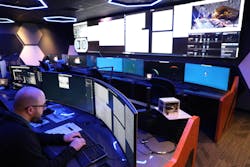WASHINGTON - For 30 total minutes in February, NASA lit a beacon on the Moon – successfully testing a sophisticated positioning system that will make it safer for Artemis-era explorers to visit and establish a permanent human presence on the lunar surface.
The Lunar Node 1 demonstrator, or LN-1, is an autonomous navigation system intended to provide a real-time, point-to-point communications network on the Moon. The system – tested during Intuitive Machines’ IM-1 mission as part of NASA’s CLPS (Commercial Lunar Payload Services) initiative – could link orbiters, landers, and even individual astronauts on the surface, digitally verifying each explorer’s position relative to other networked spacecraft, ground stations, or rovers on the move., Jonathan Deal writes for NASA. Continue reading original article.
The Military & Aerospace Electronics take:
18 March 2024 -“We’ve lit a temporary beacon on the lunar shore,” said Evan Anzalone, LN-1 principal investigator at NASA’s Marshall Space Flight Center in Huntsville, Alabama. “Now, we seek to deliver a sustainable local network – a series of lighthouses that point the way for spacecraft and ground crews to safely, confidently spread out and explore.”
“This feat from Intuitive Machines, SpaceX, and NASA demonstrates the promise of American leadership in space and the power of commercial partnerships under NASA’s CLPS initiative,” NASA Administrator Bill Nelson said in a statement after the landing. “Further, this success opens the door for new voyages under Artemis to send astronauts to the Moon, then on to Mars.”
NASA's deal writes that "Marshall engineers designed, developed, integrated, and tested LN-1 as part of the NPLP (NASA-Provided Lunar Payloads) project funded by the agency’s Science Mission Directorate. Marshall also developed MAPS (Multi-spacecraft Autonomous Positioning System), the underlying networked computer navigation software. MAPS previously was tested on the International Space Station in 2018, using NASA’s Space Communications and Navigations (SCaN) Testbed."
Jamie Whitney, Senior Editor
Military + Aerospace Electronics

